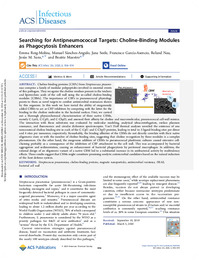Por favor, use este identificador para citar o enlazar este ítem:
https://hdl.handle.net/11000/34207Registro completo de metadatos
| Campo DC | Valor | Lengua/Idioma |
|---|---|---|
| dc.contributor.author | Roig-Molina, Emma | - |
| dc.contributor.author | Sánchez-Angulo, Manuel | - |
| dc.contributor.author | Seele, Jana | - |
| dc.contributor.author | García-Asencio, Francisco | - |
| dc.contributor.author | Nau, Rolan | - |
| dc.contributor.author | Maestro, Beatriz | - |
| dc.contributor.other | Departamentos de la UMH::Producción Vegetal y Microbiología | es_ES |
| dc.date.accessioned | 2025-01-08T09:11:15Z | - |
| dc.date.available | 2025-01-08T09:11:15Z | - |
| dc.date.created | 2020-03-05 | - |
| dc.identifier.citation | ACS Infectious Diseases 2020, 6, 954-974 | es_ES |
| dc.identifier.issn | 2373-8227 | - |
| dc.identifier.uri | https://hdl.handle.net/11000/34207 | - |
| dc.description.abstract | Choline-binding proteins (CBPs) from Streptococcus pneumoniae comprise a family of modular polypeptides involved in essential events of this pathogen. They recognize the choline residues present in the teichoic and lipoteichoic acids of the cell wall using the so-called choline-binding modules (CBMs). The importance of CBPs in pneumococcal physiology points to them as novel targets to combat antimicrobial resistances shown by this organism. In this work we have tested the ability of exogenously added CBMs to act as CBP inhibitors by competing with the latter for the binding to the choline molecules in the bacterial surface. First, we carried out a thorough physicochemical characterization of three native CBMs, namely C-LytA, C-Cpl1, and C-CbpD, and assessed their affinity for choline and macromolecular, pneumococcal cell-wall mimics. The interaction with these substrates was evaluated by molecular modeling, analytical ultracentrifugation, surface plasmon resonance, and fluorescence and circular dichroism spectroscopies. Van’t Hoff thermal analyses unveiled the existence of one noncanonical choline binding site in each of the C-Cpl1 and C-CbpD proteins, leading in total to 5 ligand-binding sites per dimer and 4 sites per monomer, respectively. Remarkably, the binding affinities of the CBMs do not directly correlate with their native oligomeric state or with the number of choline-binding sites, suggesting that choline recognition by these modules is a complex phenomenon. On the other hand, the exogenous addition of CBMs to pneumococcal planktonic cultures caused extensive cellchaining probably as a consequence of the inhibition of CBP attachment to the cell wall. This was accompanied by bacterial aggregation and sedimentation, causing an enhancement of bacterial phagocytosis by peritoneal macrophages. In addition, the rational design of an oligomeric variant of a native CBM led to a substantial increase in its antibacterial activity by multivalency effects. These results suggest that CBMs might constitute promising nonlytic antimicrobial candidates based on the natural induction of the host defense system. | es_ES |
| dc.format | application/pdf | es_ES |
| dc.format.extent | 21 | es_ES |
| dc.language.iso | eng | es_ES |
| dc.publisher | American Chemical Society | es_ES |
| dc.rights | info:eu-repo/semantics/openAccess | es_ES |
| dc.rights | Attribution-NonCommercial-NoDerivatives 4.0 Internacional | * |
| dc.rights.uri | http://creativecommons.org/licenses/by-nc-nd/4.0/ | * |
| dc.subject | Streptococcus pneumoniae | es_ES |
| dc.subject | choline-binding proteins | es_ES |
| dc.subject | magnetic nanoparticles | es_ES |
| dc.subject | antimicrobial resistance | es_ES |
| dc.subject | DEAE | es_ES |
| dc.subject | bacterial cell wall | es_ES |
| dc.subject.other | CDU::5 - Ciencias puras y naturales::57 - Biología::579 - Microbiología | es_ES |
| dc.title | Searching for Antipneumococcal Targets: Choline-Binding Modules as Phagocytosis Enhancers | es_ES |
| dc.type | info:eu-repo/semantics/article | es_ES |
| dc.relation.publisherversion | https://doi.org/10.1021/acsinfecdis.9b00344 | es_ES |

Ver/Abrir:
Searching for Antipneumococcal Targets Choline-Binding Modules.pdf
7,02 MB
Adobe PDF
Compartir:
 La licencia se describe como: Atribución-NonComercial-NoDerivada 4.0 Internacional.
La licencia se describe como: Atribución-NonComercial-NoDerivada 4.0 Internacional.
.png)